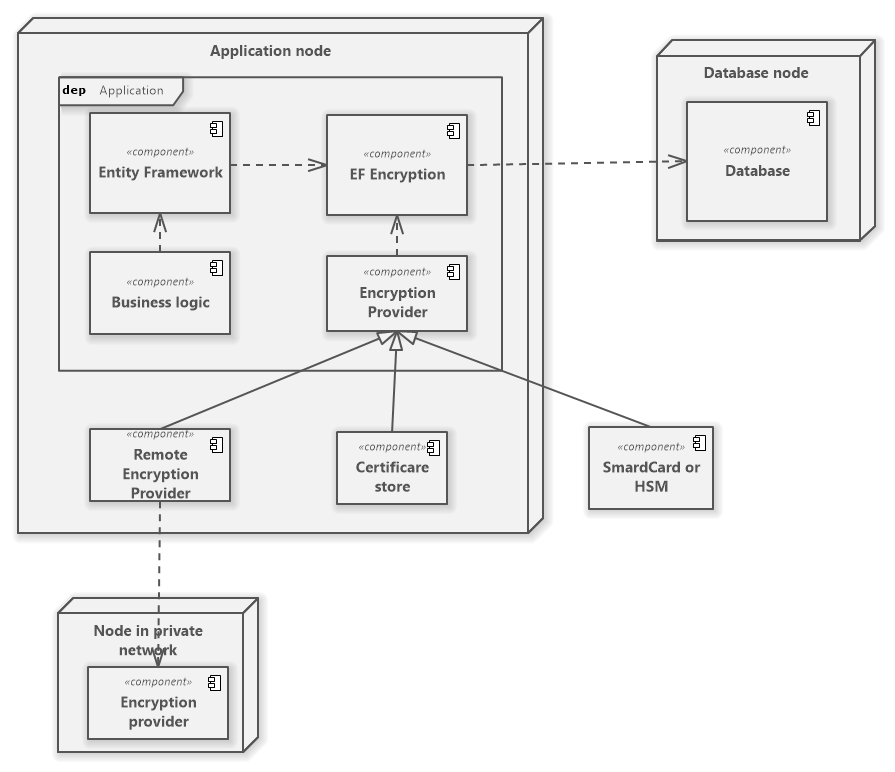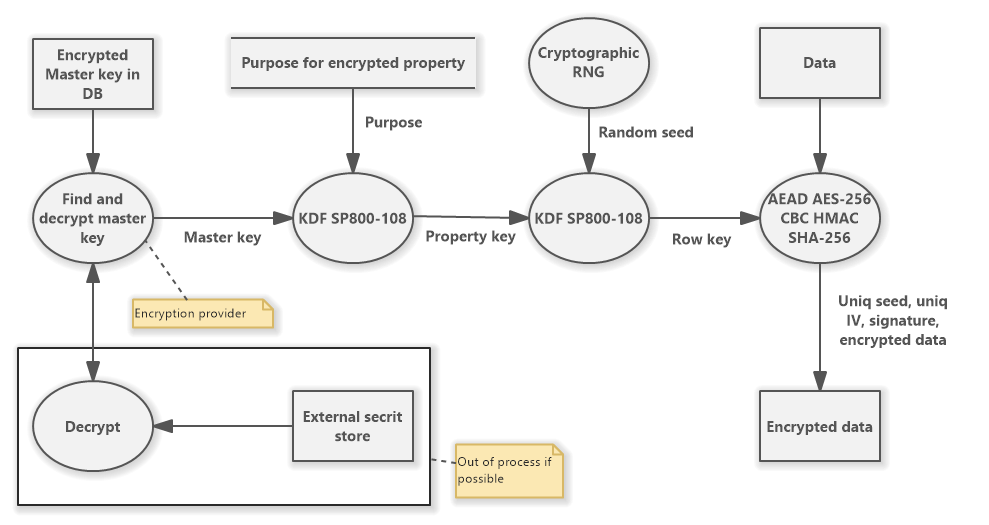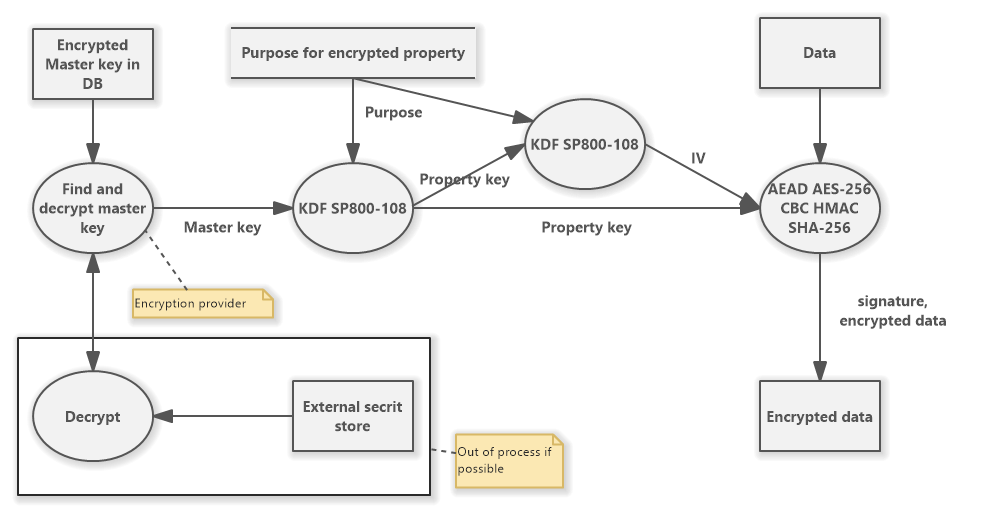Add transparent data encryption to Entity Framework Core inspired Always Encrypted from MS SQL Server.
Harrison314.EntityFrameworkCore.Encryption is a Microsoft Entity Framework Core extension to add support of encrypted fields using built-in or custom encryption providers.
- Database agnostic (tested on Sqlite, MS SQL Server, PostgreSQL, Azure CosmosDB).
- Key rotation.
- Simple for use.
- Deterministic or randomized encryption.
- Build using standard cryptographic algorithms (AES, AES_GCM, HMAC SHA2, SP800-108, PBKDF-2,...).
- Data compression (GZip, LZW).
- Internal or external (out of process or on another server e.c. Azure Key Valut) encryption providers.
- Emergency KillSwitch (e.g. for wipe private keys and exiting application when the smartcard is ripped off).
- Encryption providers:
- Password (only for testyng),
- Ceratiricate (Recomandedt use with Windows store with non exportable private keys or SmartCard.),
- PKCS11 data objects (in contrib library),
- Remote provider (in contrib library),
- DPAPI provider (in contrib library),
- Custom provider (custom implementation of
IDbContextEncryptedCryptoProvider).
The following dataflow diagrams shows the encryption and derivation of the key
for a record property with EncrypetionType.AEAD_AES_256_CBC_HMAC_SHA_256.
With randomized encryption mode:
With deterministic encryption mode:
Alternative encryption type EncrypetionType.AES_GCM use equivalent derivation keys and nonce.
Original data model:
public class Patient
{
public int Id { get; set; }
public string FirstName { get; set; }
public string LastName { get; set; }
public string SocialSecurityNumber { get; set; }
public string OtherId { get; set; }
public bool Alert { get; set; }
public string Notes { get; set; }
public virtual ICollection<Visist> Visists { get; set; }
}
public class Visist
{
public int Id { get; set; }
public DateTime Date { get; set; }
public string Note { get; set; }
// and other
}
public class SampleDbContext : DbContext
{
public DbSet<Patient> Patients
{
get;
set;
}
public DbSet<Visist> Visits
{
get;
set;
}
public SampleDbContext(DbContextOptions options)
: base(options)
{
}
protected override void OnModelCreating(ModelBuilder modelBuilder)
{
modelBuilder.Entity<Patient>(p =>
{
p.HasKey(t => t.Id);
p.Property(t => t.FirstName).IsRequired().HasMaxLength(150);
p.Property(t => t.LastName).IsRequired().HasMaxLength(150);
p.Property(t => t.SocialSecurityNumber).IsRequired().HasMaxLength(150);
p.Property(t => t.Notes).HasDefaultValue(string.Empty);
p.HasMany(t => t.Visists).WithOne(t => t.Patient).HasForeignKey(t => t.PatientId);
});
modelBuilder.Entity<Visist>(p =>
{
p.HasKey(t => t.Id);
});
}
}Run in project folder:
dotnet add package Harrison314.EntityFrameworkCore.Encryption
In Startup.cs register DbContext and Encryption Context for DbContext:
public void ConfigureServices(IServiceCollection services)
{
services.AddDbContext<SampleDbContext>(builder =>
{
builder.UseSqlServer(this.Configuration.GetConnectionString("PrimaryDb"));
});
services.AddEncryptedContext<SampleDbContext>()
.WithPasswordEncryptionProvider("Passw0rd*"); // Password provider is only for testing, use other provider
}Insert AddEncryptionContext to ModelBuilder and mark encrypted properies with purpose, algorithm and mode.
- purpose - must by uniq string for property in context. Do not change after deploy to production!
- algorithm - chiper and AEAD algorithm.
- mode - Deterministic or randomized.
- compressionMode - Compression mode for compression plaintext data.
public class SampleDbContext : DbContext
{
public DbSet<Patient> Patients
{
get;
set;
}
public DbSet<Visist> Visits
{
get;
set;
}
public SampleDbContext(DbContextOptions options)
: base(options)
{
}
protected override void OnModelCreating(ModelBuilder modelBuilder)
{
modelBuilder.AddEncryptionContext();
modelBuilder.Entity<Patient>(p =>
{
p.HasKey(t => t.Id);
p.Property(t => t.FirstName)
.HasEncrypted("Patient.FirstName",
EncrypetionType.AEAD_AES_256_CBC_HMAC_SHA_256,
EncryptionMode.Randomized,
CompressionMode.None)
.IsRequired().HasMaxLength(150);
p.Property(t => t.LastName)
.HasEncrypted("Patient.LastName",
EncrypetionType.AEAD_AES_256_CBC_HMAC_SHA_256,
EncryptionMode.Randomized,
CompressionMode.None)
.IsRequired().HasMaxLength(150);
p.Property(t => t.SocialSecurityNumber)
.HasEncrypted("Patient.SocialSecurityNumber",
EncrypetionType.AEAD_AES_256_CBC_HMAC_SHA_256,
EncryptionMode.Deterministic,
CompressionMode.None)
.IsRequired().HasMaxLength(150);
p.Property(t => t.Notes).HasDefaultValue(string.Empty);
p.HasMany(t => t.Visists).WithOne(t => t.Patient).HasForeignKey(t => t.PatientId);
});
modelBuilder.Entity<Visist>(p =>
{
p.HasKey(t => t.Id);
});
}
}Only in encrypted scope is poosible working with encrypted properties.
public class PatientController : Controller
{
private readonly SampleDbContext context;
private readonly IDbContextEncryptedProvider<SampleDbContext> encryptionProvider;
public PatientController(SampleDbContext context, IDbContextEncryptedProvider<SampleDbContext> encryptionProvider)
{
this.context = context;
this.encryptionProvider = encryptionProvider;
}
[HttpGet(Name = "GetAllPatients")]
[ProducesResponseType(typeof(List<PatientInfo>), 200)]
public async Task<IActionResult> GetAll()
{
IEncryptedScopeCreator scopeProvider = await this.encryptionProvider.EnshureEncrypted();
using IDisposable encryptedScope = scopeProvider.IntoScope();
List<PatientInfo> result = await this.context.Patients.OrderBy(t => t.Id).Select(t => new PatientInfo()
{
FirstName = t.FirstName,
Id = t.Id,
LastName = t.LastName
})
.ToListAsync();
return this.Ok(result);
}
}Find records by encrypted property:
IEncryptedScopeCreator scopeProvider = await this.encryptionProvider.EnshureEncrypted();
using IDisposable encryptedScope = scopeProvider.IntoScope();
Patient patient = await this.context.Patients.Where(t => t.SocialSecurityNumber == ssn).SingleOrDefaultAsync();Update non-encrypted column without encrypt and decrypt:
using IDisposable defaultValuesScope = this.encryptionProvider.EnshureDefaultValues().IntoScope();
Patient patient = await this.context.Patients.FindAsync(id);
patient.Notes = model.Notes ?? string.Empty;
await this.context.SaveChangesAsync();


